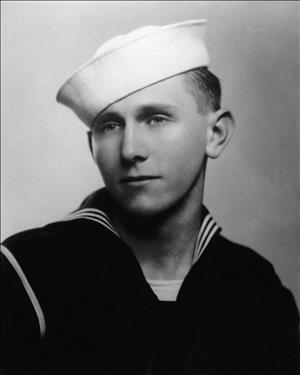On May 24, 1943, President Franklin D. Roosevelt (1882-1945) awards the Medal of Honor to Coast Guard Signalman Douglas Albert Munro (1919-1942) of South Cle Elum for his heroism in the 1942 battle of Guadalcanal, in which he was killed. Munro's parents accept the medal in a White House ceremony. His heroism helped save the lives of 500 U.S. Marines, 25 of them wounded. On September 27, 1942, during the battle for Guadalcanal in the South Pacific, Signalman Munro commanded a landing detachment of 10 boats that rescued a Marine force trapped on the beach. When enemy fire threatened to destroy the last boats recovering the Marines, Munro positioned his boat between the enemy and the other boats. He drew the fire, ensuring that the other boats could escape, and was fatally wounded. Douglas Albert Munro is the only United States Coast Guard member to receive the Medal of Honor. Following his death his mother became an early volunteer for the Women's Reserve of the Coast Guard.
Raised in South Cle Elum
Douglas Albert Munro was born in Vancouver, British Columbia. When he was 3 years old the family moved to Vancouver, Washington. They soon relocated to South Cle Elum, Kittitas County, on the east slope of the Cascades, where Douglas attended South Cle Elum Grade School and Cle Elum High School. Douglas was active in the high-school band and the Cle Elum Drum and Bugle Corps. He graduated from high school in 1937 and spent one year at Central Washington College of Education (later Central Washington University).
Munro enlisted in the United States Coast Guard on September 18, 1939, with a desire to save lives. He had training at Port Angeles, Clallam County, on the Olympic Peninsula and served on the Coast Guard cutter USCGC Spencer.
Signalman Douglas A. Munro
In 1942, following the U.S. entry into World War II, Munro went aboard the USS Hunter Liggett and that September he was assigned to a landing-craft pool to provide amphibious support to U.S. Marines assaulting Japanese military positions on Guadalcanal in the Solomon Islands. On September 27, 1942, a Marine force went ashore and drove inland about 500 yards when they encountered a much stronger Japanese force and were in danger of being driven into the sea. Signalman First Class Munro commanded the 10-landing-craft detachment that had landed the Marines.
Receiving word of their predicament, Munro returned with the boat detachment to save them. He guided the boats to shore under heavy enemy fire. The boats laid down automatic-weapons fire as the Marines boarded the boats. As soon as a boat was loaded it pulled out. As the boats pulled away, the enemy fire increased on the remaining few boats. To save the Marines still escaping, Munro placed his boat between the other boats and the Japanese forces. He drew the fire, enabling the remaining Marines to escape. Munro was hit in the head by an enemy bullet. His last words were "Did they get off?"
Douglas Albert Munro's heroism helped save the lives of 500 Marines, including 25 wounded, and led to his being awarded the Medal of Honor. President Franklin D. Roosevelt presented the medal to to Munro's parents James (1891-1962) and Edith F. (1895-1983) Munro in a ceremony held in the White House on May 24, 1943. Munro became the first and, as of 2015, only Medal of Honor recipient from the United States Coast Guard.
Remembering Douglas Albert Munro
After the death of her only son Edith F. Munro joined the Women's Reserve of the Coast Guard (named "Semper Paratus Always Ready" or "SPARs"). Munro completed her Women's Reserve training on May 27, 1943, three days after the White House ceremony. Her first assignment was to spend six months traveling around the United States relating the Coast Guard story. On October 1, 1943, she assumed command of the Coast Guard Base Seattle Women's Reserve (SPARs) barracks. On July 1, 1944, she was promoted to lieutenant. She retired on November 1, 1945. Edith Munro continued to have an active Coast Guard role after her retirement. She attended many dedications and other Coast Guard events. In 1982 she attended a 40th-anniversary commemoration of the Battle of Guadalcanal.
Two ships were named in Douglas Munro's honor. First was a destroyer escort launched on March 8, 1944, with Lieutenant Junior Grade Edith F. Munro christening it. That ship was decommissioned in 1960, and then sunk as a target in January 1966. A second ship with his name, a Coast Guard cutter, was launched on September 27, 1971. The USCGC Munro remains in service in 2015.
Douglas Munro was originally buried on Guadalcanal. After the war his remains were brought home to the City of Cle Elum cemetery, Laurel Hill Memorial Park. His grave is within a family plot where his mother and father are also buried. The Douglas A. Munro Memorial, a monument honoring him, stands in the cemetery near the plot where he is buried. A wall of the memorial, listing the men and women who served in each war, is dedicated to service members from Cle Elum. Two flags are flown at the memorial, a Coast Guard flag and the American flag. An anchor chain from a Coast Guard ship serves as a fence around Munro's burial plot. His statue is in the Washington, D.C., Coast Guard Headquarters building that carries his name.

